Candid Portrait Photography: A Complete Guide to Capturing Authentic Moments
Every photographer has that one shot that clients can’t stop talking about. Dad’s head thrown back in laughter, Mom wiping a tear, the kids collapsing into each other. Three frames before anyone remembered you were there. That unguarded moment became the framed centerpiece over their fireplace and the reason four of their friends booked you the same week.
That’s candid portrait photography: hunting raw, unscripted emotion instead of directing a scene. Clients scroll past perfection for something that feels real, and authentic moments signal the storytelling they’re looking for—whether for weddings, families, or brands.
Genuine smiles crease differently from "say cheese" grins, and everyone knows it. A portfolio packed with authentic moments signals storytelling chops that modern clients explicitly seek, whether they're booking wedding coverage or brand shoots.
The challenge? Candid work means mountains of images, and culling through thousands can make anyone stick to safe poses. Smart workflow tools like Aftershoot handle the heavy lifting, so you spend more time catching those fireplace-worthy moments and less time stuck behind a screen.
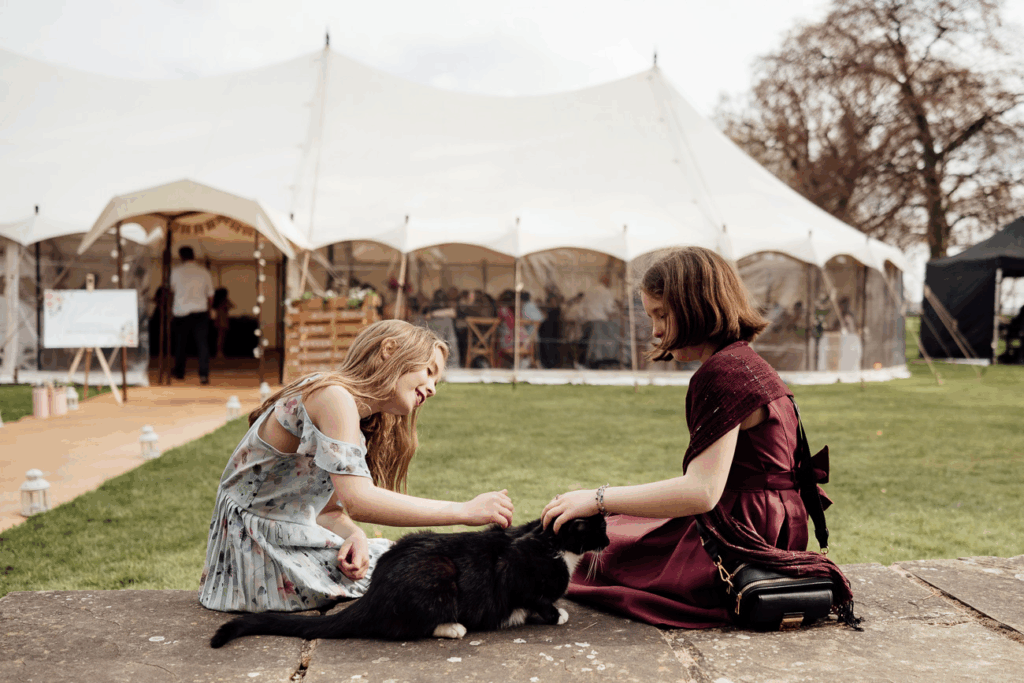
What is Candid Portrait Photography?
If you've ever clicked the shutter just as a toddler belly-laughed at their dad's terrible joke, you know exactly what authentic candid portrait photography is all about. You're capturing genuine emotion in real time, no performance, no "say cheese," just pure human moments. A candid portrait freezes authentic expressions: spontaneous laughter, concentrated frowns, or that fleeting look couples share across a crowded reception.
The difference between candid and traditional portraits? One's natural, the other's orchestrated. One happens in real environments, the other needs studio setups. One feels like a memory, the other like a marketing shot.
Today, authentic portraits dominate weddings. The reason? Clients don't want stiff family photos that their grandparents wouldn't recognize. They want images that feel lived-in and real. But candid photos are equally powerful in family sessions, lifestyle campaigns, street photography, and travel stories.
A single frame communicates context, relationships, and atmosphere faster than any posed shot ever could. Ready to dive into the gear, mindset, and systems that make authentic portraits repeatable? Let's go.
TL;DR
Before we dive deep, here are the game-changing principles that separate compelling candid work from amateur snapshots:
Linger strategically. The best candid portraits don't happen on command; they sneak up on you. Park yourself in good light and wait. Let people walk into your frame, let conversations unfold, and give that decisive moment space to appear. Those unguarded beats are the soul of authentic photography.
Travel light. Big, clunky gear screams "camera!" and flips your subject's "perform" switch. A compact mirrorless body with a silent shutter — the kind photographers swear by, keeps you invisible and your subjects authentic.
Prepare clients thoughtfully. Even "unposed" sessions run smoother when everyone knows the plan. Tell clients you're hunting for real moments, offer loose prompts, then fade into the background. Simple expectation-setting melts nerves fast.
Master fast culling. You'll shoot hundreds of frames to catch one perfect smirk, don't waste evenings sorting them. AI tools slash culling time by flagging the keepers, letting you get back to adding that finesse instead of clicking through endless files.
Choose story over perfection. A slightly soft image that oozes emotion crushes a technically flawless statue every time. Modern clients crave authenticity; story-driven frames reign supreme. Chase feeling first, polish later.
Essential Gear for Candid Portrait Photography
Photography communities consistently agree on one thing: gear size matters for candid work. As many forum discussions reveal: "No matter what kind of equipment you're using, getting your camera ready and setting up your shot through the viewfinder often takes far too long for a candid shot to come out well." It's about staying invisible, fast, and ready for any lighting curveball life throws at you.
The theme throughout these forums? Anything that makes subjects forget the camera exists is a win.
Best Cameras for Candid Portraits
Compact mirrorless bodies with near-silent shutters, eye-tracking AF, and dual card slots are your secret weapons. They're small enough to blend into a crowd but tough enough to survive a frantic wedding dance floor.
The Sony A7 III remains a bargain workhorse with class-leading Eye AF and a hush-quiet electronic shutter you can't hear over a whisper. When you're capturing that quiet moment between ceremony and reception, the silent mode lets you document without disrupting the intimacy. This combo of stealth and performance is why it's still a staple for so many authentic shooters.
The Fujifilm X-T5 weighs a bit more than a cup of cold brew and brings iconic dials for lightning-quick changes. It's film-stock colors, nail skin tones straight out of the camera, which means less time fixing wonky white balance later. The street-friendly footprint is a blessing when you need to disappear into the background of a family gathering.
Dual card slots are sanity insurance. When that once-in-a-lifetime laugh erupts, you don't want a corrupted single card killing your vibe or your reputation.
Add a low-profile sling strap so you can let the camera dangle by your hip, hands-free until the moment unfolds. Extra batteries and spare cards live in a small cross-body pouch. No rolling suitcase announcing "pro photographer on deck" here.
Prime Lenses for Natural Candid Shots
Fast primes aren't just about that buttery bokeh everyone obsesses over. They gulp light like a thirsty photographer at happy hour, letting you ditch flash and stay stealthy.
35mm: A classic for a reason
The 35mm is the go-to for environmental shots where the background matters. It's close enough for intimacy but wide enough to tell the whole story. Picture this: grandpa teaching his grandson to tie his shoes while the family bustles around the kitchen. The 35mm captures both the tender moment and the chaotic love surrounding it.
50mm: For flattering candid closeups
The 50mm gives you that classic "human eye" perspective without screaming "telephoto stalker." It quietly flatters faces and feels natural to both you and your subjects. When someone's mid-laugh at a dinner party, the 50mm frames them perfectly without making other guests wonder what you're up to.
85mm: For chaotic moments
The 85mm lens gives you working distance at events, plus that flattering compression clients adore. It isolates subjects even in cluttered scenes, turning a messy birthday party into a portrait-worthy moment. The extra reach means you can snipe genuine reactions from across the room without waving a white flag of intimidation.
Not sure why your lighting is just not working out? Check out this quick guide to ace lighting that will ease your editing process
Dial In Settings Before the Moment
A 70–200mm f/2.8 zoom lets you adapt quickly, but it's also a conversation starter you might not want. Choose your battles.
Shoot Aperture Priority around f/2 to f/4 — shallow enough for separation but with wiggle room for imperfect focusing. Pair that with Auto-ISO capped at 6400 and a minimum shutter of 1/250s so sudden laughter doesn't blur into mush.
Keep continuous AF-C active with face/eye detection. Back-button focusing means you can recompose on the fly without losing lock on your subject's eyes. For street work, zone-focus a 35mm at roughly two meters and you'll nail decisive moments before autofocus even wakes up.
Read also: Mastering Camera Settings
Lighting Tips for Natural, Authentic Shots
Authentic portraits feel honest because the light feels honest. Hunt for side or backlight during golden hour—rim glow without studio strobes. Window light indoors turns curtains into free diffusers.
Bright overcast becomes the ultimate softbox with no setup required. When a toddler's having a meltdown in the park, even cloud cover saves you from harsh shadows and squinty eyes.
When ambient light isn't enough, a collapsible reflector or sheet of white foam board kicks gentle fill without invading personal space. If you must add artificial light, a palm-sized LED panel set to low power and feathered off the subject keeps things believable.
The less you fiddle with gear, the more you observe, and observation is the lifeblood of authentic work. You don't need every lighting modifier or the latest camera body to create compelling portraits. What you need is a repeatable system that lets you walk into any situation with confidence, adapt to the unexpected, and deliver consistent results.
How to Shoot Candid Portraits: Step-by-Step
Every unforgettable authentic portrait starts long before you press the shutter and keeps paying dividends long after the files hit your hard drive. Think of it as a three-act play: set the scene, let the drama unfold, then curate the highlight reel.
1. Before the Shoot: Prep & Planning
Trust is your secret weapon. Spend ten minutes chatting about anything but photography: coffee preferences, goofy pet stories, weekend plans. That simple rapport makes the difference between stiff half-smiles and the belly laugh you'll frame on the wall.
Next, co-create a "moments moodboard." Pull a dozen reference images — kids twirling, grandparents mid-hug, lovers lost in conversation—and ask clients which moments hit home. The exercise sets expectations and quietly tells everyone, "We're chasing feelings, not forced poses."
Wardrobe matters more than most photographers realize. Loose fabrics, pockets (hands love somewhere to hide), and solid or subtle patterns move well and won't fight for attention. Leave tight jackets, jangly jewelry, and neon brights in the closet unless they serve the story.
Location scouting is half art, half logistics. Look for places where real life already happens: a favorite park bench, a sun-splashed kitchen, or a bustling side street.
While you're scouting, clock the best ambient light, note reflective surfaces for natural fill, and make sure you're not barging into a culture that frowns on spontaneous photography.
Gear prep is your final pre-game ritual. Silent shutter engaged, Auto-ISO capped, dual cards formatted, and a fast prime attached. The goal? Zero fiddling once emotion kicks in. This front-loading takes time, but it buys you priceless authenticity when the big moments arrive.
2. During the Shoot: Blending In & Capturing Emotionw
Your mission is simple: disappear without actually leaving. Start by positioning yourself where action converges, doorways, dance floors, café counters, then let people walk into your frame.
Staying put feels counterintuitive, but it works. Subjects may become less aware of you over time, but there is no scientifically established timeframe for when this happens. When movement stalls, spark it.
Ask a couple to tell the story of their first date, hand a toddler a bubble wand, or challenge friends to a silly contest. Prompts like these redirect attention away from the lens and onto genuine interaction.
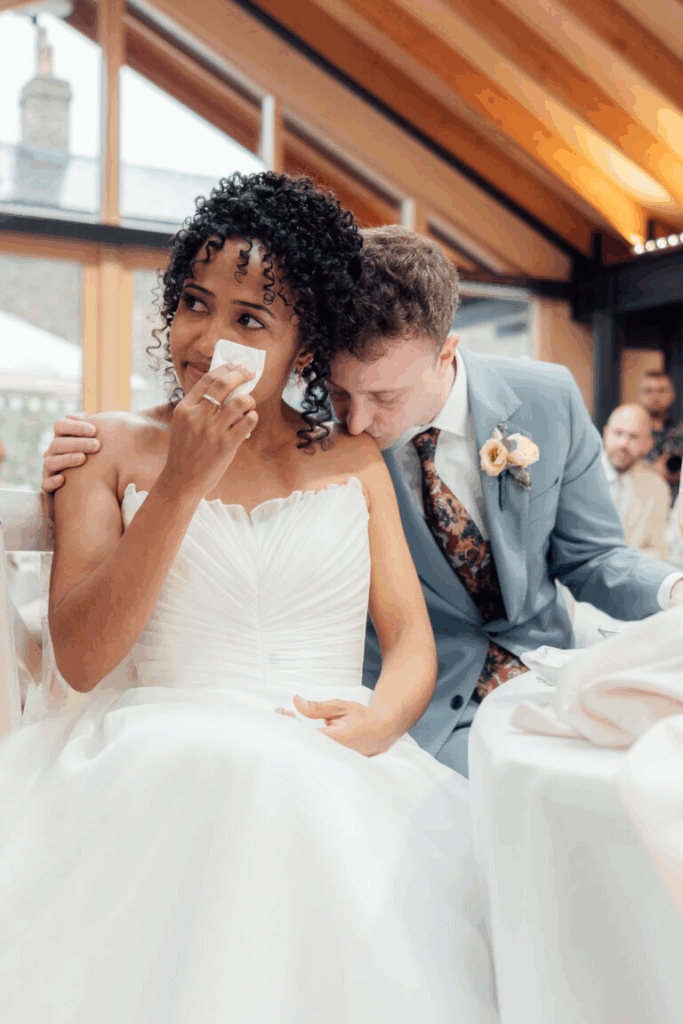
Capture the sequence in burst mode. Micro-expressions change faster than you can say "cheese." Composition becomes your stealth narrator. Layer foreground blur by shooting past foliage or a café window to frame the scene and add depth. Watch your edges, too; Caroline Maryan's cropping rules remind us never to amputate at wrists or ankles.
Technical hygiene keeps chaos in check. Glance at the histogram every few minutes, especially when drifting from shade to sun. If you're street-roaming, practice "shooting from the hip": camera at waist level, zone-focused, and angled slightly upward. It's not just ninja-cool. It avoids direct eye contact that snaps people out of natural mode.
Occasionally, someone will notice the camera and freeze. Smile, lower your gear, and keep chatting until tension breaks. Half the time, they forget you're still shooting; the other half, you've earned permission to keep going.
Volume is your insurance policy. Aim for 3–5 variations of every promising moment: wide establishing, mid portrait, tight detail. Variety lets you tell a richer story and gives clients more to love.
3. After the Shoot: Culling, Editing & Delivery
First rule: back up before you even think about scrolling through thumbnails. Two drives minimum, no exceptions.
Next comes culling, the notorious time-sink. Run a two-pass system: rapid star-or-trash sweep, then slower storytelling selection. In the Backcountry Gallery Photography Forums, photographers regularly discuss their culling workflow struggles.
One photographer shared: "Import into LR, go through images and hit X on crap/OOF/non-keepers, which flags them as rejected... It's a slow, methodical process."
With a thousand-image wedding, this used to be a weekend job until AI culling changed the game. Aftershoot does the heavy lifting - flags blinks, soft focus, and near-duplicates, surfacing keepers in minutes instead of hours.
Before you add another tool to your plate, see how it actually feels to use it. Our self-guided demo lets you try Aftershoot’s culling, editing, and retouching right in your browser.

Once the shortlist is locked, consistent editing maintains your signature look while adjusting per-image exposure. Do a quick polish pass. Some photographers choose to export sneak peeks within 24 hours, but this is not standard practice across the industry, and ride that fresh-session buzz straight into social shares and client gushing.
Delivery timelines depend on session type. Families see their full gallery in about two to four weeks; weddings can take closer to four weeks, but speed matters. The faster clients relive those raw emotions, the stronger the word-of-mouth.
Throughout, keep edits light: grain stays, laugh-lines stay, color stays true to the day. Over-processing is authenticity's worst enemy. Finally, archive both RAWs and finals, update your editing workflow with any stylistic tweaks, and crack a celebratory beverage.
Candid Portrait Photography Post-Processing Workflow
You've survived the shoot, swapped batteries, and backed up your cards. Now the real magic (and, let's be honest, the real time-sink) begins. Post-processing a batch of candid portraits can feel like wading through a digital bog, but a repeatable workflow turns that swamp into a slip-n-slide.
- Cull with AI – Let Aftershoot’s AI culling sift through thousands of frames in minutes, keeping the sharp, emotive shots and ditching the blinks and near-duplicates.
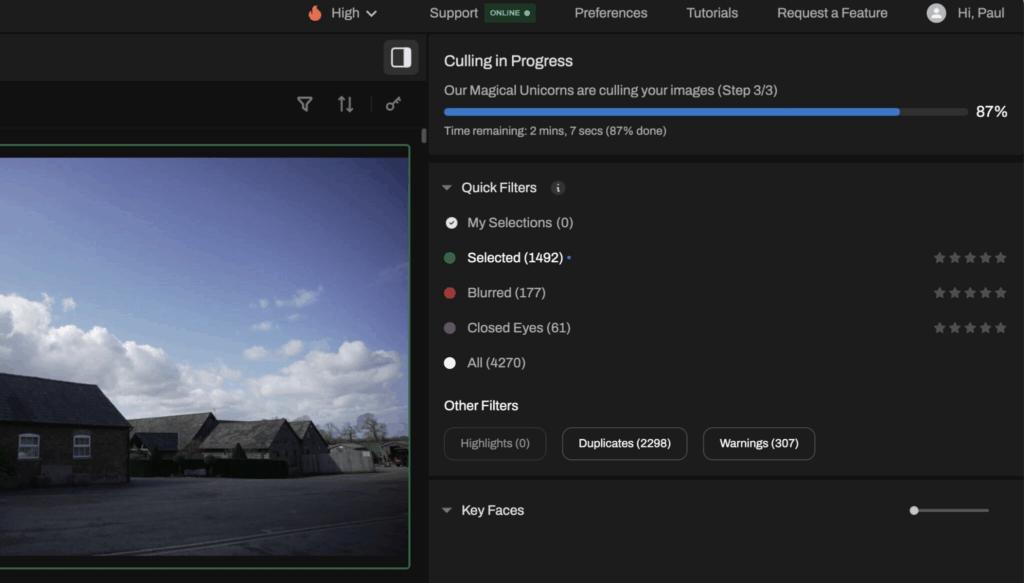
- Apply consistent edits – Use Aftershoot’s AI Editing to apply your style across the entire gallery, so every image feels like it belongs.
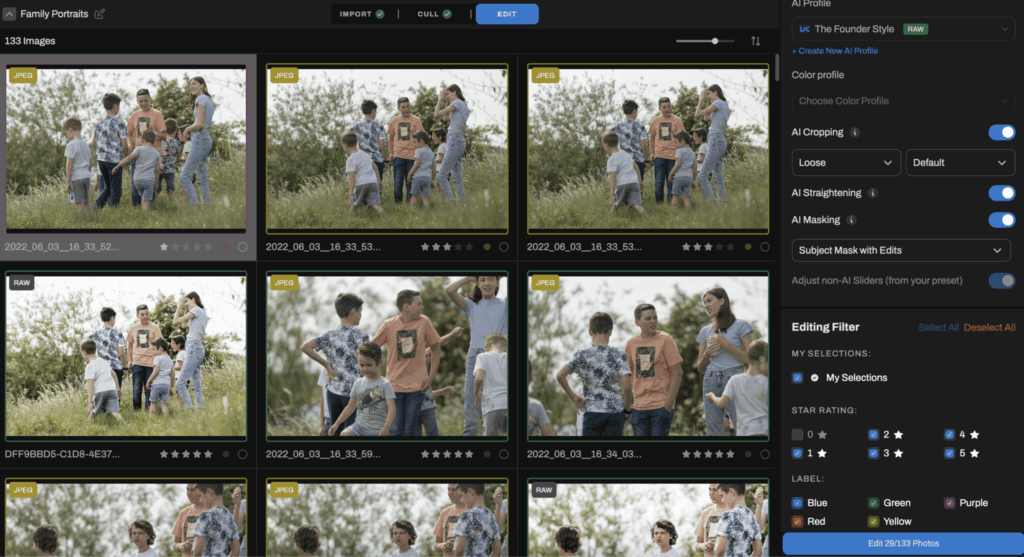
- Fine-tune in your editor – Bring the gallery into Lightroom (or your preferred editor) for any creative tweaks or artistic adjustments.
- Polish with AI retouching – Run images through Aftershoot Retouch for quick, natural, and consistent touch-ups, especially handy for portraits where skin, fabric, and small distractions need finessing.
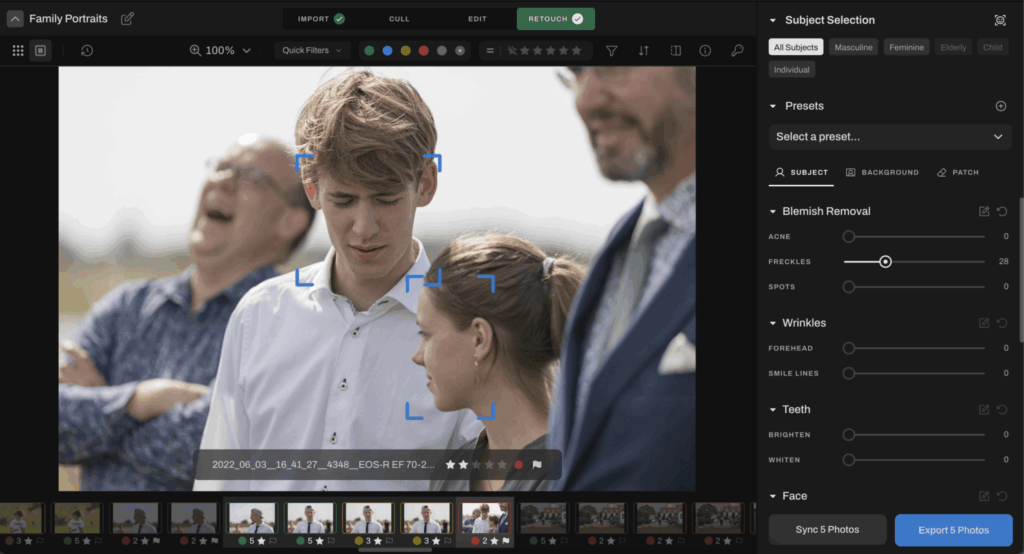
- Export & deliver – Prep your final files for print or digital delivery, confident that your gallery tells one seamless visual story.
Let AI shoulder the grunt work
Automation isn't about surrendering control; it's about reclaiming evenings lost to slider fatigue. The AI handles the repetitive "same but different" tweaks, while you focus on storytelling polish — cropping tighter on that belly laugh or bumping contrast on a tear-wiping hug.
Dial in this system once, and future sessions drop into a rinse-and-repeat groove. Your clients get cohesive, on-brand images faster, and you get your weekend back.
How much do Candid Portrait Photographers Make?
Candid photography can bring in anything from side-hustle cash to a full-time living — it all depends on what you shoot, your market, and how you manage your time.
Where the income comes from:
- Family & lifestyle sessions – Shorter shoots, quick turnarounds, steady demand.
- Weddings – Command premium rates for 8–12 hours of high-pressure, high-emotion coverage.
The more emotion you capture and the more distinctive your look, the higher your rates can climb.
The hidden profit killer:
- Your booking fee doesn’t tell the full story — your effective hourly rate does.
Example: 2 hours shooting + 6 hours editing turns “$150/hour” into far less once you factor in post-production.
Where a hybrid workflow changes everything:
- Cull in minutes – AI surfaces only the best, sharp, eyes-open frames.
- Edit in bulk – AI editing applies your signature style across the gallery instantly.
- Polish fast – AI retouching finishes portraits with natural, consistent results.
The payoff:
- Reduce post-processing from 8 hours to 1.
- Offer same-day sneak peeks or rush upgrades clients happily pay extra for.
- Deliver slideshows or highlight reels before the reception ends.
- Turn a single wedding weekend into multiple billable shoots.
- Present a polished, cohesive portfolio that justifies premium rates.
Consistent color, emotion-first framing, and lightning-fast delivery signal a premium experience long before you mention price. Combine that perception with a lean, AI-powered workflow and you're no longer trading time for dollars — you're trading unmistakable storytelling for whatever the market can bear.
Streamline Your Candid Photography Workflow with Aftershoot
You’ve done the hard part, capturing emotion your clients will treasure for years. Now let Aftershoot handle the busywork so you can deliver faster, book more, and keep your creative energy where it belongs: behind the camera, not behind a screen. Try it today with a 30-day free trial.
